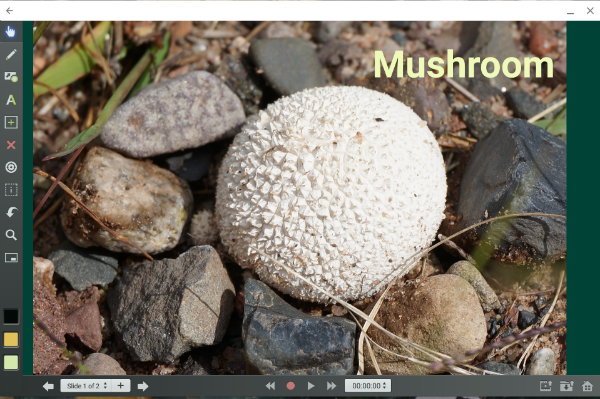This is a repeat from 2002 with a few additions. What a wild ride it has been. After 5 editions we a commercial publisher, our book is now available through Kindle in combination with some online resources. The online resources are available at no cost to all. The Kindle edition is approximately 15% of the cost of the 5th edition from the publisher.
The True Story of How Mark and Cindy Became Authors (Short Version)
Scene 1: Visitors Center – Theodore Roosevelt National Park (early 1990s)
 Mark and Cindy discover the North Dakota Wildlife Coloring Book. This coloring book consisted of simple line drawings of North Dakota fish and animals. Mark and Cindy recognize that these images might be scanned and used in student projects. Mark contacts North Dakota Game and Fish to obtain permission to use images in this way. (Note: He later offers a proposal to Game and Fish that if they would hire an artist to create a more complete series of images, he would digitize the images, create a HyperCard stack to organize the images, write a short manual of suggestions for classroom use of these images, and distribute these materials to teachers. State Game and Fish names Mark Grabe to the Project Wild Advisory Board. The clip art collection still lives and is now available online.)
Mark and Cindy discover the North Dakota Wildlife Coloring Book. This coloring book consisted of simple line drawings of North Dakota fish and animals. Mark and Cindy recognize that these images might be scanned and used in student projects. Mark contacts North Dakota Game and Fish to obtain permission to use images in this way. (Note: He later offers a proposal to Game and Fish that if they would hire an artist to create a more complete series of images, he would digitize the images, create a HyperCard stack to organize the images, write a short manual of suggestions for classroom use of these images, and distribute these materials to teachers. State Game and Fish names Mark Grabe to the Project Wild Advisory Board. The clip art collection still lives and is now available online.)
Scene 2: Pam Carlson’s Classroom – The Butterfly Project
The first major classroom project actually created using coloring book images was conducted in the classroom of second grade teacher Pam Carlson. Pam was known to us as a creative teacher interested in involving students in projects. We worked with Pam to implement several projects involving butterflies. One of the projects made use of clip art generated from a butterfly coloring book. Students each were assigned a butterfly, learned as much as they could about “their butterfly” from library resources, created a picture incorporating the butterfly image within Kid Pix, and eventually create a three card, Hypercard stacks incorporating the colored butterfly images and the information the students had learned about the butterfly. Newer versions of the butterfly project are still described in our books.
Scene 3: Some large bookstore in some large city (the details are a little vague)
Mark and Cindy are attending an American Educational Research Association Convention and are exploring a large bookstore (at the time we did not have this type of mega-store in Grand Forks, North Dakota). In this store, we locate a large collection of topical coloring books. There are books on plants, animals, Native Americans, historical events, etc. An idea emerges. Perhaps the company producing all of these resources does not realize just how useful all of these images would be to teachers in a form appropriate to computer supported projects. Perhaps the company would be willing to repurpose these coloring books as clip art collections and market the collections to schools. The company publishing all of the coloring books was Houghton Mifflin.
Scene 4: Loretta Wolozin (Houghton Mifflin Education Editor) Visits the Grabes in Grand Forks
When Mark returns home from the convention, he writes a proposal for Houghton Mifflin. He proposes the development of a product that would consist of a disk of clip art, a copy of the coloring book, and a short manual that would both establish a rationale for curriculum related projects using the clip art (history, biology, etc.) and would explain how to create several specific types of projects (incorporating clip art in word processing documents, incorporating clip art into more complete images using a “paint program”, simple multimedia projects using HyperCard). The proposal and a couple of sample projects are sent off to Houghton-Mifflin.
Nothing happens for several weeks. Eventually, Mark receives a call from Loretta Wolozin. She explains that the trade division (I think that was what it was called) was not interested in the clip art proposal. However, somehow, the proposal for a coloring book related clip art collection had come to the attention of someone in the college division. It turns out the ideas for how students might use technology are regarded as different and interesting. Loretta, who has the responsibility for the books used in the preparation of teachers, wants to know if she can fly to Grand Forks and look at some of our work. I can’t say I have taken many phone calls like this. Loretta came to Grand Forks, sat in front on an Apple Macintosh LC and went through our examples of student projects. I guess she liked what she saw. We are asked to submit an outline for a book and sample chapters. The core of our books then and now remains authentic student projects.
The fourth edition of the book I have just described will be released in a couple of months. Among other things, this brief description is a way of thanking Loretta Wolozin, Pam Carlson and the teachers we have worked with over the years. Taking a chance on an approach that was different, when it involved learning new skills and new ways of doing things (in the case of the teachers) or investing money (in the case of Loretta), is still greatly appreciated.
There is probably another message in this story. We have enjoyed some personal success because of what most would describe as a string of fortuitous events (translate – we were lucky). However, if you are lucky enough to do work you find to be valuable, productive and fun, you don’t always have to search for opportunities. Sometimes, opportunities find you.
42 total views

You must be logged in to post a comment.